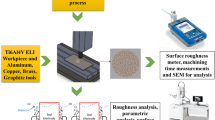Abstract
The study investigates the erosion phenomenon of the micro-electrical discharge milling (µED-milling) while fabricating microslots on titanium grade 2 alloy. Control parameters such as voltage, capacitance and depth of cut (DOC) are varied during experimentation. Material removal rate (MRR), tool wear rate (TWR) and electrode wear ratio (EWR) are the response measures evaluated to visualize the effect of variation of control parameters. An in-depth analysis of the erosion mechanism is done by characterizing the optical microscopy images of the machined cavities and the worn-out tools. Empirical models of MRR, TWR and EWR as functions of the control parameters are formulated by regression analysis. Thereafter, desirability analysis is applied to simultaneously optimize all the responses by assigning equal weightage and importance. Maximum composite desirability of 0.646 is attained at 104 pF, 110 V and 1000 µm. The analysis of variance test revealed that capacitance and voltage are more significant to all the responses than the DOC. A good correlation between the experimental and predicted values is achieved from residual analysis, which signifies the adequacy of the regression models. From the confirmation test, the highest error of 7.77% is observed between the experimental and predicted values of TWR, which justifies the desirability approach in simultaneous optimization of all the responses.













Similar content being viewed by others
References
Kar, S.; Patowari, P.K.: Electrode wear phenomenon and its compensation in micro electrical discharge milling: A review. Mater. Manuf. Process. 33, 1491–1517 (2018). https://doi.org/10.1080/10426914.2018.1453144
Kar, S.; Patowari, P.K.: Experimental Investigation of Machinability and Surface Characteristics in Microelectrical Discharge Milling of Titanium, Stainless Steel and Copper. Arab. J. Sci. Eng. 44, 7843–7858 (2019). https://doi.org/10.1007/s13369-019-03918-3
Jahan, M.P.; Wong, Y.S.; Rahman, M.: A study on the quality micro-hole machining of tungsten carbide by micro-EDM process using transistor and RC-type pulse generator. J. Mater. Process. Technol. 209, 1706–1716 (2009). https://doi.org/10.1016/j.jmatprotec.2008.04.029
Mehfuz, R.; Ali, M.Y.: Investigation of machining parameters for the multiple-response optimization of micro electrodischarge milling. Int. J. Adv. Manuf. Technol. 43, 264–275 (2009). https://doi.org/10.1007/s00170-008-1705-0
Karthikeyan, G.; Garg, A.K.; Ramkumar, J.; Dhamodaran, S.: A microscopic investigation of machining behavior in μED-milling process. J. Manuf. Process. 14, 297–306 (2012). https://doi.org/10.1016/j.jmapro.2012.01.003
Kuriachen, B.; Mathew, J.: Experimental investigations into the effects of microelectric-discharge milling process parameters on processing Ti–6Al–4V. Mater. Manuf. Process. 30, 983–990 (2015). https://doi.org/10.1080/10426914.2014.984206
Kuriachen, B.; Mathew, J.: Effect of powder mixed dielectric on material removal and surface modification in microelectric discharge machining of Ti–6Al–4V. Mater. Manuf. Process. 31, 439–446 (2016). https://doi.org/10.1080/10426914.2015.1004705
Jafferson, J.M.; Hariharan, P.; Ram Kumar, J.: Effect of non-electrical parameters in μED milling: an experimental investigation. Int. J. Adv. Manuf. Technol. 85, 2037–2047 (2016). https://doi.org/10.1007/s00170-015-7933-1
Unune, D.R.; Mali, H.S.: Experimental investigation on low-frequency vibration-assisted µ-ED milling of Inconel 718. Mater. Manuf. Process. 33, 964–976 (2018). https://doi.org/10.1080/10426914.2017.1388516
Karthikeyan, G.; Ramkumar, J.; Dhamodaran, S.; Aravindan, S.: Micro electric discharge milling process performance: An experimental investigation. Int. J. Mach. Tools Manuf. 50, 718–727 (2010). https://doi.org/10.1016/j.ijmachtools.2010.04.007
D’Urso, G.; Giardini, C.; Lorenzi, S.; Quarto, M.; Sciti, D.; Silvestroni, L.: Micro-EDM milling of zirconium carbide ceramics. Precis. Eng. 65, 156–163 (2020). https://doi.org/10.1016/j.precisioneng.2020.06.002
Arun Pillai, K.V.; Hariharan, P.; Krishna Murthy, R.: Micro ED milling of Ti–6Al–4V with SiC nano powder mixed dielectrics at different ranges of discharge energy. SILICON (2020). https://doi.org/10.1007/s12633-020-00578-z
Kar, S.; Sarmah, P.; Baroi, B.K.; Patowari, P.K.: Drilling of Micro-holes in Titanium Using Micro-EDM: A Parametric Investigation. In: Biswal, B.B., Sarkar, B.K., and Mahanta, P. (eds.) Advances in Mechanical Engineering. Lecture Notes in Mechanical Engineering. pp. 589–600 (2020)
Masuzawa, T.; Tönshoff, H.K.: Three-dimensional micromachining by machine tools. CIRP Ann. 46, 621–628 (1997). https://doi.org/10.1016/S0007-8506(07)60882-8
Karthikeyan, G.; Ramkumar, J.; Aravindan, S.: Performance analysis of µED-milling process using various statistical techniques. Int. J. Mach. Mach. Mater. 11, 183 (2012). https://doi.org/10.1504/IJMMM.2012.045984
Mia, M.; Bashir, M.A.; Khan, M.A.; Dhar, N.R.: Optimization of MQL flow rate for minimum cutting force and surface roughness in end milling of hardened steel (HRC 40). Int. J. Adv. Manuf. Technol. 89, 675–690 (2017). https://doi.org/10.1007/s00170-016-9080-8
Bobbili, R.; Madhu, V.; Gogia, A.K.: Multi response optimization of wire-EDM process parameters of ballistic grade aluminium alloy. Eng. Sci. Technol. an Int. J. 18, 720–726 (2015). https://doi.org/10.1016/j.jestch.2015.05.004
Ghosh, N.; Pal, P.K.; Nandi, G.: GMAW dissimilar welding of AISI 409 ferritic stainless steel to AISI 316L austenitic stainless steel by using AISI 308 filler wire. Eng. Sci. Technol. an Int. J. 20, 1334–1341 (2017). https://doi.org/10.1016/j.jestch.2017.08.002
Tamang, S.K.; Natarajan, N.; Chandrasekaran, M.: Optimization of EDM process in machining micro holes for improvement of hole quality. J. Brazilian Soc. Mech. Sci. Eng. 39, 1277–1287 (2017). https://doi.org/10.1007/s40430-016-0630-7
Author information
Authors and Affiliations
Corresponding author
Rights and permissions
About this article
Cite this article
Kar, S., Patowari, P.K. An Experimental Investigation of the Erosion Phenomenon in µED-Milling of Titanium and Its Parametric Optimization Using Desirability Analysis. Arab J Sci Eng 47, 8847–8861 (2022). https://doi.org/10.1007/s13369-021-06387-9
Received:
Accepted:
Published:
Issue Date:
DOI: https://doi.org/10.1007/s13369-021-06387-9



